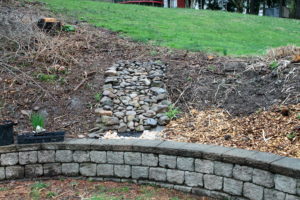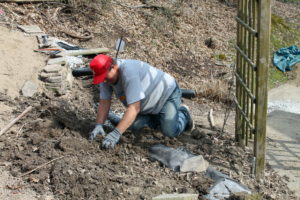Water on a Slope
April 23rd, 2019
When water heads down a slope, especially in heavy rains, it doesn’t always behave nicely.
Instead of soaking in, it can create channels or sheets that wash out everything in its path.
Planting in these wash-out zones is futile. Even groundcovers end up at the bottom when a gully-washer erodes the soil underneath.
Soil tends to be thin on slopes anyway, which discourages deep rooting. So what’s the answer?
I’m using a variety of strategies on the fairly steep bank behind my new house in Pittsburgh. One or more of them might help you as well if you have a slope at your place.
The previous owners of my new house apparently ignored the slope-runoff situation, allowing weeds and seeded-in maidenhair grasses (Miscanthus) to soften the flow along with a few channels dumping water into and across the lawn below.
Much of that lawn was soggy all winter. After any substantial rain, it stays wet for days.
Some of the water makes its way across the lawn to another slope down to the driveway. That slope is leveled a bit by a brick retaining wall at the bottom. Steps come down the middle of it.
During heavy rains, water runs down the steps like a multi-tiered waterfall. While that’s a nice touch, it’s not a whole lot better than having a waterfall gushing out the second-floor window from the bathtub overflowing.
My first goal was to deal with the biggest push of water coming into the yard in the first place from the neighbor’s sloped lawn above. I could see that water over the years had found (or created) a natural swale to cascade down my bank behind a block retaining wall that previous owners had built at the bottom of the bank, where the lawn begins.
No system was in place to deal with that rush of water. I’m surprised the soil behind the wall never eroded away.
I decided to extend that block wall to where I’m adding a new fence to try and discourage deer (which is another whole story).

This swaled rock bed should carry direct runoff into the catch basin and pipe behind the retaining wall.
Anyway, I cut the swale a little deeper and installed rubber liner topped with large river pebbles. At the bottom of this new rocky stream bed where the water runs into the wall, I installed a catch basin.
The catch basin sends water out a 4-inch corrugated pipe that I buried behind the existing block wall and the new 14-foot section of wall that I added. The pipe is surrounded by coarse limestone (for drainage), and the whole thing is wrapped in landscape fabric to keep soil from migrating into the pipe.
If all goes well, heavy runoff should go down the stream bed, into the basin, down the buried pipe, and through more buried pipe the whole way to the gutter in the street out front. I’d eventually like to cut short the pipe and have the pipe empty into a rain garden in order to keep water out of the storm-sewer system altogether.
The whole idea of this is to “go with the flow” by guiding water from where it wants to go to where I want it to go.
This was a ton of work for an old guy, but it’s better than having washouts, a soggy yard, and worst of all, the potential for wet basements.
Somewhere along the line, previous owners had tried stone terracing on the back slope. That’s another excellent way to deal with slopes.
However, the loosely laid stones weren’t very big and over the years had washed out themselves. They were laying aimlessly all over the bank – mostly covered by weeds and floppy grasses.
I decided to try some new terracing on the lower slope leading to the driveway (the one with the waterfalls coming down the steps). So I scavenged the biggest and best stones from the back slope and added them to stones that once lined my Mechanicsburg water garden.
I carried the back-slope stones one by one down the steps, and I drove the Mechanicsburg stones to Pittsburgh in my heavily laden Hyundai Sonata (loaded and unloaded stone by stone).
The latter stones needed a new home because the new owners in Mechanicsburg didn’t want the water garden. Part of the sales deal was that I remove it.
With stone on hand, I’m building a series of three curving stone retaining walls, staggered so that water has no option of coming straight down the slope anywhere.
Terracing helps by reducing the grade of a slope. By backfilling behind the walls, you end up with more level (or at least less sloped) beds. That, in turn, slows water and gives it more of a chance to soak in instead of rush down.
I’ll be planting the terraces in hopes that plant roots will help stabilize and hold the backfilled soil.
I also set each layer of stone back an inch or two from the edge of the stones below. That’ll help create a slight lean back to counteract the weight of the soil and its push when freezing in winter.
A third strategy I’m using where I don’t think channels are occurring is planting right into the slope.
Three shrubs I’m planning to use are Virginia sweetspire (Itea), summersweet (Clethra), and witch alder (Fothergilla). All three are natives that are good at quickly colonizing soil. I’m hoping they’ll grow enough to hold the bank.
Then I’ll groundcover below the shrubs, probably with pachysandra because it’s cheap, quick to fill in, evergreen, and not a favorite with deer. I might also try lamium and variegated Solomon’s seal.
My main concern is to get all of this in place, growing, and mulched before a heavy rain comes along.
I really don’t want to see my truck-load of soil flowing in a brown stream down the street.









